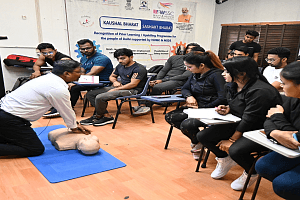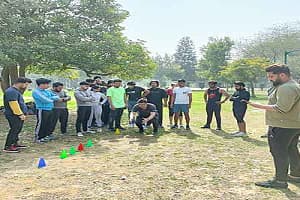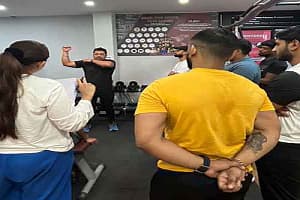Functional Training: Improving Everyday Movement

Functional fitness training is a type of strength training that readies your body for daily activities. These exercises equip you for the most important type of physical fitness, the kind that preps you for real-life, daily living stuff like bending, twisting, lifting, loading, pushing, pulling, squatting and hauling. Most functional fitness contains multi-joint movement patterns that involve your knees, hips, spine, elbows, wrists, and shoulders, which all build strength and improve your range of motion.
It is a form of exercise that emphasizes movements and patterns that are essential for daily activities. It aims to improve the body's ability to perform functional movements efficiently, such as pushing, pulling, twisting, bending, and squatting. Unlike traditional weightlifting, functional Training incorporates multiple muscle groups, joints, and planes of motion at the same time.
In recent years, functional training has become more popular as a dynamic and useful method to fitness Functional training, that improves broad strength, stability, and mobility, differs from traditional exercises in that it focuses on moves that mimic real-life jobs. You can perform functional strength training workouts frequently without concern for injury.
Benefits of Functional Training
Better Overall Movement Patterns: Functional training improves balance, coordination, and proprioception by training motions rather than specific muscles.
Improving Core Stability: 'Functional exercises exercise on the deep supports, which are crucial for maintaining stability to prevent injuries, and the other core muscles.
Increased Functional Power: Through this training, you will be able to lift heavier objects, climb stairs, and carry groceries with less risk of injuries. This training focuses on enhancing your strength in everyday activities.
Injury Prevention: By instruction of movement patterns and the improvement of stability in joints, practical training aids in lowering the risk of injuries when participating in regular activities and competing in sports.
Better Results in Sport and Athletics: Functional training promotes sports-specific motions, agility, and power, which results in improved performance in a variety of sports and athletic activities.
Functional training involves a wide range of exercises that simulate everyday movements. Some common exercises include:
Squats: Squats work the muscles of the lower body and strengthen the legs by simulating the motions of lying down and standing up.
Lunges: Lunges focus the lower body and enhance balance and stability while simulating stepping and walking motions.
Push-ups: Push-ups develop the chest, arms, and arms, which are essential for pushing movements by using the upper body muscles.
Deadlifts: target the backside muscles, which include the glutes, the hamstrings and lower back. They simulate the act of lifting a thing from the ground.
Medicine roller rotational throws: These exercises, who simulate the movements used in sports like tennis and golf, increase rotational strength and core stability.
Incorporating Functional Training into Your Routine
To incorporate this type of training into your fitness routine, consider the following tips:
Start with Basic Movements: Focus on proper form and technique as you start with basic exercises like squats, lunges, and push-ups.
Make Progress Gradually: As your endurance and balance improves, gradually raise the level of difficulty and volume of the exercises.
Use equipment : Like stability balls, medicine balls, and resistance bands to give your workouts more variety and difficulty.
Seek Expert Guidance: If this is your first time training, you might want to explore working with a professional fitness instructor who can create a program tailored for your requirements and objectives.
Functional training is an extremely effective fitness technique that improves performance and everyday movement. This kind of training enhances general power, stability, and mobility, resulting in enhanced functionality and a decreased chance of injuries by emphasizing motions that mimic real-life activities.
Before beginning any new workout regimen, keep in mind to speak with a healthcare provider or fitness specialist, particularly if you have any current medical concerns or injuries. Maintain consistency, pay attention to your body, and take pleasure in the process of using functional training to enhance daily movement and performance.
Functional Exercise That’s improve daily Exercise
Consider functional exercises to assist strengthen and enhance your capacity to carry out these everyday motions. With or without equipment, you can do these exercises that focus mobility at home.
As you go about your day, you may reduce the chance of injury in addition to growing healthier and more confident.
Motion of Pressing
When pushing yourself out of bedtime, extending and reaching to put items on a shelf, or pushing self up from a sitting to standing posture, you are using a pressing motion.
The muscles that are most used are those in the chest, arms, shoulders, and core. Strengthen your muscles using modified chest press to assist prevent injury when doing a regular act.
Chest Press Modified
Starting Position: Stand with your back to a wall, extend your arms out in front of you, slant your head slightly forward, and press the palms of your hands against the wall with the tips of your fingers no higher than your chest.
Bend your elbows as you inhale so that your nose is nearly in contact with the wall.
Exhale and return your palms to the starting position.
Increase to 12–15 repeats.
Pulling Motion
When performing yard chores like raking or weeding or opening doors or taking items out of cabinets, a pulling action is used.
Back, shoulders, biceps, and core are the main muscle used. Practice rows for 12 to 15 reps a couple times per week to help keep these muscles from obtaining hurt.
Stepping and Bending
When picking up items off the ground, climbing stairs, squatting, sitting, or tying shoes, knee and hip governing actions are performed.
The gluteal, hamstrings, quadriceps, calves, and core muscles are mostly used during this exercise. Your body can be improved with chair exercises to help you move around the rest of the day without turning into hurt
Alternating Directions
When you stretch across your body, you rotate your torso.
Core, oblique, gluteal, and core were the main muscle groups used. To reduce your risk of injury when reaching, do the torso twist.






